
Donate to Innerviews
Since 1994, Innerviews has provided uncompromising, in-depth interviews with musicians across every genre imaginable. And it does that with no trackers, cookies, clickbait, or advertising.
Your donations are welcome to help continue its mission of highlighting incredible music and artists, without any commercial considerations.
Your contributions will be instantly transformed into stories and videos, and cover hosting and web management costs. Importantly, your dollars will help ensure Innerviews remains absolutely free to all visitors, independent of their ability to financially support it.
Please consider making a donation today by using the PayPal QR code below.

Zoë Keating
Reflecting Motion
by Anil Prasad
Copyright © 2010 Anil Prasad.
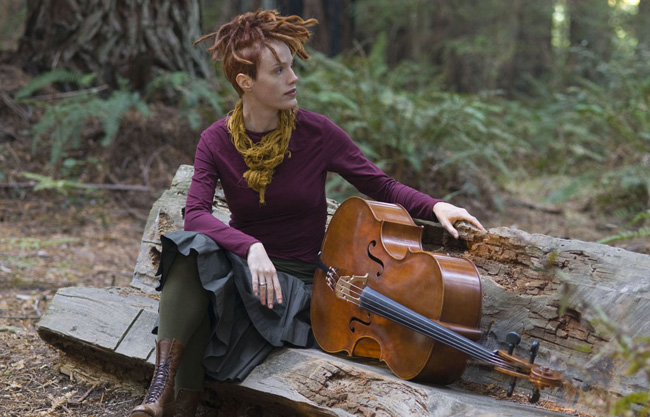
Cellist Zoë Keating isn’t content to wait around for the music industry to complete its achingly slow reinvention for the Internet era. She’s taken matters into her own hands and carved out a unique niche for herself by using social media to create buzz and engage her fan base.
Keating's work focuses on loop-based solo cello work. Using a minimalist software setup, she weaves together layers of sound, including lush and melodic elements, pulsing rhythms, and spectral atmospheres. Her third release Into the Trees captures her compelling and addictive approach at its most evolved. The album reflects the Canadian-born artist’s transition from urban life in San Francisco to her current existence in the woods of Northern California’s Camp Meeker.
As with her previous albums, 2005’s Natoma and 2004’s One Cello x 16, Keating’s determined DIY outreach approach has enabled Into the Trees to find a mainstream audience. She eschews all traditional marketing efforts, finding no use for labels, managers, booking agents, or publicists. Instead, she’s a master at using social networking to promote her music, with 1.3 million Twitter followers, and strong Facebook, MySpace, and iTunes presences. Keating also relies on left-of-center performance opportunities at tech conferences, punk events, churches, warehouses, and jazz clubs to continue building her large and loyal following.
To date, Keating has sold more than 30,000 copies of her albums and has hit number one on the iTunes classical and electronica charts. Even more impressive, her new album has spent weeks in the Top 10 of Billboard's classical charts. Her work has also caught the ears of several luminaries, including Tears For Fears’ Curt Smith, film composer Mark Isham, DJ Shadow, and most notably, eclectic singer-songwriter Imogen Heap. Heap learned of Keating the same grassroots way her fans have. She first heard Keating’s music on MySpace, bought a CD from her website, and proceeded to ask her to perform with her on several tours. Keating has also composed scores for several independent films, including 2008’s Ghost Bird and 2004’s Frozen Angels.
Describe the mood and atmosphere you sought to capture on Into the Trees.
I’m unsure if it’s a chicken or egg situation for me. Am I trying to create something from scratch or am I creating something as a reaction to something else? It’s a very abstract process. Once I left my urban life in San Francisco and started making new music out here in the woods, I noticed certain themes were developing and I went with them. I don’t know if something creatively new was emerging or if it was about me getting in touch with my new environment. What I do know is I was trying to capture a feeling of motion, about moving towards or away from something, and that this thing is unknown. I think of this album as moving into an unknown world. Having been an urbanite for so long, the forest sort of represents that. But to be honest, I always have a lot more opinions about what my music means after I create it than I do as I’m making it. When I’m making music, I don’t have that perspective. That feeling of spaciousness and motion was always around though.
I tend to have a lot of music in my head all the time. I’m always coming up with these little repetitive segments. There’s a big motion element in both where the music comes from and the way the music itself sounds. When I lived in San Francisco, 75 percent of the pieces I wrote came from me riding my bicycle through the city while singing to myself. Cycling itself is a repetitive motion, so the melodic segments I would improvise would also be repetitive. They would often last for my entire ride. Here in the woods, I experience something similar when walking. It’s hard for me to walk by myself and not sing at the same time, so that’s where some bits come from now. I also dream some musical phrases. I’ll come up with them in my head during the night. I think my creative process is me trying to work out all of these little pieces in my head.
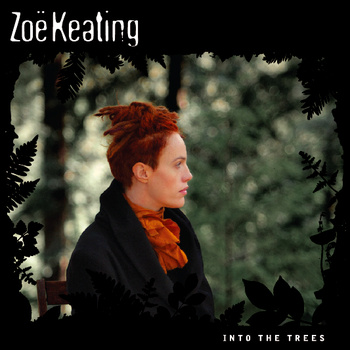
How are you chronicling your initial thoughts?
Unfortunately, for me, I don’t use anything. I have a MacBook Pro I do everything on in the studio, but when I’m cycling or walking, it’s frustrating to not have something to record things on. I even get ideas while driving. I’ll be in the car and start singing and think “That bit was so genius. I can’t wait to go into the studio to record it.” Then I’ll forget it. I’ve started calling myself on the phone and singing ideas into my voicemail so I don’t lose them. That’s the most reliable method.
Is there a 1:1 relationship between your vocalizations and what you play on the cello?
It starts out as a 1:1 relationship. When I initially record the ideas, I’ll actually play them on my cello as I was actually singing them. But it takes me months to create a piece of music. There are a lot of layers in the music. I spend a lot of time working out what the arrangements should be. I’ll play a bunch of phrases, record them all, and then re-record them to change the voicings. I’ll play a phrase in a standard way and try different ways as well. I might make a voicing ponticello or pizzicatto, so the whole piece sits together. The process is a lot like sound design. I take these inspirational snippets and assemble them into three-dimensional objects, in which some parts are in the foreground and others are in the background. And then it becomes a winnowing process in which I’ll have, say 200 snippets that get trimmed down into 50. Eventually it becomes a piece. [laughs]
You’re experimenting with loops all the time. How do you transform those experiments into compositions?
It starts from one simple phrase and it builds in complexity from there. I’ll do a lot of improvising to move things along. For instance, if I have a little fragment I was singing in my car on the way to the grocery store, I’ll start improvising with that fragment. I have hard drives full of long strings of improvisation. Sometimes the improvisations are simplistic, so I’ll take them and engage in some more MIDI sequencing that enables me to add more complex phrases. Things build from there. A piece might initially run 30 seconds, and then it becomes a minute long, and then a minute-and-a-half. I’ll keep going until it feels complete.
I tend to do better working on deadlines. If I’m going on tour with someone, I always try to have at least one new piece together, and preferably two. That’s my rule. The technology is always changing, so I always have some new tool I’m integrating into the tour that I’ve never used before. So, I’ll create new pieces which are really about me teaching myself how to use this new trick and incorporate it into what I do. A lot of pieces on the new album were created that way.
What technology did you use to make Into the Trees?
It’s the same setup I use on stage, which is Ableton Live and SuperLooper. I’m very much a minimalist. I became a minimalist because I was broke. [laughs] There’s nothing like being broke to make you a minimalist. Everything is recorded on my MacBook Pro using a Motu UltraLight audio interface, the software and a nice microphone. That’s it. I don’t even use a preamp. What I do is take my cello, attach microphones to it and the audio from the cello goes into the computer and is processed by Ableton Live and SuperLooper. I use them for different types of looping and layering effects. I typically record cello phrases, then play them back and determine the phrases that work best together.
The wizardry is that the software automates the process. I know how the pieces are going to go, so I set up what I call an empty MIDI score prior to recording. It’s a series of automated, hands-free MIDI messages. For instance, the message might say “Record for four bars. Stop recording. Now, go to track two. Record for two bars. Stop recording. Now, mute track one. Record track three for six bars. Now, record track four. Now, fade up track two slowly.” All I have to do is play the right thing at the right time. Obviously, if I play the wrong thing, the computer will record me playing something different. And then a brand new piece of music emerges. And in fact, a lot of my pieces emerge out of mistakes. Often, those mistakes sound pretty cool and I’ll incorporate them into a new song.
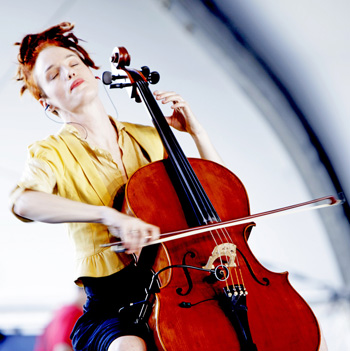
Describe the cello you use and what makes it special.
It was made by Robert Brewer Young. I met him in New York when I played with Rasputina, a cello-based rock band I was in from 2002 to 2006. He was the guy who would repair my cello when I visited New York. When you fly with a cello, you might get a crack, a seam might split, or you’ll need the bridge adjusted. I was always complaining about what was wrong with my cello, so he made me a new one. The cello has a few things that are unique. It’s very big and the back of the cello is one solid piece of wood, which is unusual. It makes the instrument more dense, so it’s more stable on stage. It doesn’t feed back like other cellos. A cello is a magnificent, resonating box. That’s what they’re designed to be. But if you’re in an amplified environment, other sound waves around it can be amplified too. This cello has a little more headroom and less feedback, which works well given what I do.
What are the biggest creative challenges you face and how do you overcome them?
My biggest problem is finishing things. I have a lot of ideas in my computer and the pieces are really living as I’m creating them. As they get close to being finished, I start to lose interest in them. When I’m initially creating the pieces, I’m in a beautiful, abstract world of emotion and sound. I really love it. The piece is a living thing. It’s like a young creature that could become a doctor, painter or the President. They really feel like evolving, digital life forms to me. But when I begin to finalize them, it’s almost like killing them. They stop living for me. That last 10 percent of polishing is really hard for me, but you have to do it to make it into a decent piece of music.
Deadlines are a really good thing for me. Having a baby a few months ago was a great deadline for me. [laughs] It was “Oh my God, I’m going to have a baby. I better finish this stuff.” Another good example was when I was asked to do a track for the Terry Riley release called In C Remixed. I contributed a piece called “Zinc” to it. My deadline was less than a week, so I had to move quickly to have my piece included. I just went downstairs and created it in that period of time. It’s funny. If I have a year to make something, I’ll take the whole year. [laughs]
How did the In C Remixed opportunity come about?
I got an email from the album’s producer, Bill Ryan, who asked me if I’d like to do a remix. So, I listened to the source recordings. They had multitracks of all the instruments from In C. It’s a really beautiful, pristine recording. I listened to everything and isolated the fragments I liked and began rearranging them on my canvas. I kept the violin in there. I was also really attracted to the clear marimba work because the cello can’t make those sounds. I chopped all of the parts into elements and it became a waterfall of sound to me. The piece felt like a musical version of a rushing cascade. I started adding cello parts to give it some gravitas, and that’s how it came together.
Has Riley heard your version?
He has. He said he really liked it. The CD version of Into the Trees was delayed because I wanted to include “Zinc” on the deluxe edition. I needed Riley’s permission to do that. A friend of mine helped me get in touch with Riley and I got a really nice email from him. It was right after I gave birth to my son. It said “I give you my full permission to use it. It’s one of my favorite versions.” That made me feel pretty good.
What evolution do you feel has occurred since you began recording as a solo artist?
My influences have changed, and that’s had an impact. Around 2002, when I was living in San Francisco, I was exposed to a lot of electronic music. I really liked the electronic music approach to sound design used by people like William Orbit. I had never really heard that kind of downtempo dance music before. I had been living under a rock. [laughs] Another one of my main influences is a guy named Jhno, a former housemate who’s both a computer music programmer and a musician. What I wanted to do was take orchestral cello music and combine it with the sound design techniques of electronic music. In other words, creating classical music with an electronic mentality—one in which I’m not concerned about physically placing instruments on a stage. It was more about combining sounds and parts.
I also started working with my friend Count in San Francisco. He mixes hip-hop records. He did DJ Shadow’s The Outsider album. He works with Galactic too. He’s the person who does the final post-production on my music. He doesn’t know anything at all about classical music. He listens to my music just like he would listen to a hip-hop album. [laughs] So I think it’s that mixture of production techniques from a different genre, with source material from another genre that’s responsible for an evolution. I think I’ve morphed past that to the point where I don’t think about that stuff anymore. It’s really much more about capturing the music in my head these days.
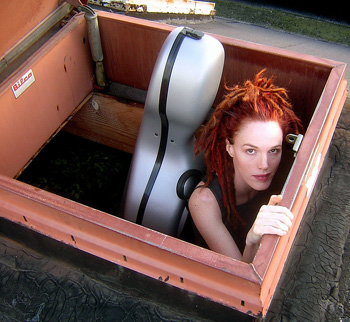
How has your cello approach progressed since you started down this path?
My new cello made me a better cellist, but I’m actually not a very good cellist, especially if you compare me to someone like Yo-Yo Ma. [laughs] I’m not as focused on my technique as I should be. I’m more focused on the overall picture. It’s like I’m an orchestral player living inside my own orchestra. I’m not a soloist. My goal is to progress to the point where people stop asking me about technology because they find the music so compelling. At that point, they won’t care how it was created. On one hand, I’ve dug my own grave with technology, but I do feel it’s the least interesting thing about the music. I want the music to speak on its own. When I was really young, my favorite thing in the entire world was to play in an orchestra. The feeling of being one of 110 people playing Beethoven’s “Symphony No. 7" was a peak life experience. I think I’ve always been trying to recreate the feeling of being in the middle of a huge cello section in my music.
How did you initially connect with Count?
We had mutual friends and he contacted me to do some cello work for a band he was in called Halou. I went and sat in with them and played some cello parts at one of their shows because their cellist wasn’t available. Then he asked me if I wanted to work on DJ Shadow’s The Outsider album. So I went into the studio, set up all my stuff and provided them with some loops. They recorded the whole session and sampled it for Shadow’s records. When I was doing my Natoma album, I really wanted somebody to do the post-production to create the sonic world I was talking about and his approach really captured what I was looking for.
You worked with Count on Inu's Not For Everyone album. Tell me about your involvement in that post-rock project.
The idea of working with the group is to do something totally different and unrelated to what I’m doing on my own. I like being in a bunch of different groups. I get bored playing by myself, so I see Inu as my other current project. The way the collaboration works with Count is he’ll send me a bunch of files and I’ll mess about with them in my system. I work that way with everyone. When I did cello arrangements for Curt Smith of Tears For Fears, I did the same thing. I even do my film work at home and work on it through a back-and-forth process. The internet makes it all possible.
Describe your home recording environment.
It’s probably not very ideal. It’s an eight-by-eight-foot room with a seven-foot ceiling made entirely out of redwood. It was built in the 1930s and it’s very dark. I call it the cello cave. [laughs] Through the windows I can see huge tree trunks that stretch up to infinity. It’s also quite damp down there, so I keep the heat on and run the dehumidifier so the cello doesn’t get too affected by the environment.
Contrast the process of creating music for yourself versus your film work.
I love writing for film because the mood is already created. I can’t create it. With my music, one piece can have six different versions that are totally different. With a film, the director gives you the footage and says “I want the piece to be dark and foreboding.” So, I have to go in that direction and it really crystallizes my work. It closes off the other possibilities and makes me focus. Creative boundaries can be a good thing for me. I work really well in a box. [laughs] You would think I’d use that technique in my own work, but I never do.
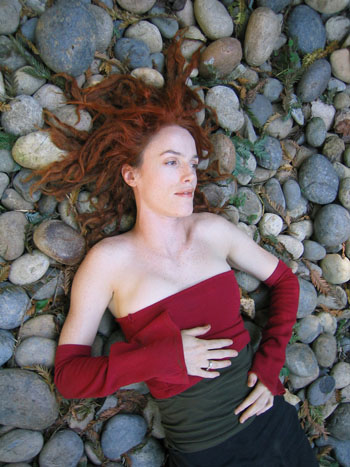
What’s your favorite soundtrack effort to date?
I like what I did for the Ghost Bird film. That was my most advanced work because I wasn’t limited by song formats. I was really free to be more experimental. I also found the subject matter very compelling, which was the idea of extinction and nature that’s lost which we can’t get back.
Have you thought about releasing some of your film music?
I’ve thought about making a CD called From the Cutting Room Floor. When I’m asked to write, say, a half-hour of music, I’ll usually create two hours of music. A lot of it will get snipped, and those snippets can be really interesting pieces. They end up not going anywhere. I think it would be interesting to compile them. It’s one of the many projects on my plate that I’d like to complete.
What are the others?
I’d really like to do an album of covers. That’s partly a fan request. Again, the limitations are what interest me. When you’re doing a cover, you’re limited by the elements of the cover that you can’t necessarily change too much. There’s also an alternate version of Into the Trees that would be interesting to put out. I once moved to Portland for eight months. It was while I was on tour with Imogen Heap, so I wasn’t there much. When I was there, I wrote music in a spare bedroom in our apartment. Then we moved to California, and somewhere during the move, I lost the disc with all the new material. I had to recreate every piece from memory. I was so angry with myself that the song ideas were gone. Now, I’ve turned into a freak that creates two backups of everything. What’s funny is that after I finished the album, I located the disc. I listened back and the pieces sound totally different in their earlier forms. It’s an alternate album. No-one but me would ever know that the pieces are linked. I think it would be really neat to release this version.
I also have an idea to record every single live performance and make them available for free to fans. Live versions tend to be so different every night. If I’m having an inspiring moment with the audience, I might extend a piece by two minutes, and that might never happen again. The other thing I’d like to do is capture the unique loops I create for each performance, and use an automated process to upload them to a server that categorizes them on the fly, and makes them available for people to use in their own music. I’m way more ambitious than I have time for. [laughs]
What impact did your work with Imogen Heap have on your career?
Those tours were really fun. I had such a great time with her. I felt like I met a kindred spirit. It was remarkable. She called me up out of the blue and said “Can you go out on tour with me in two weeks?” [laughs] We hit it off right away. It was like we had known each other forever. It was also a great opportunity because it exposed me to an entirely new audience that never would have found me otherwise. I think it took my career to a whole new level. I got a lot more exposure. She also has the same standards I have. I feel like I owe it to myself and the audience to make music that’s as good as it can possibly be. If it’s sub-par, I don’t want to do it. I’d rather do nothing than do something that’s mediocre. Imogen is exactly the same way. She has classical training like me. She’s a serious musician working in a pop format. She could easily change careers and become a serious composer. It felt very inspiring to spend every day with someone like that. What makes me sad is that we live so far away from each other. I would love to pop down to her house in London and improvise together more often.
What’s your overall philosophy when it comes to using Twitter to promote your work to your one million-plus followers?
I tend to dip in the stream. Not all of those people are listening at any one time. I had my record release, which was really just me telling people about it on Twitter. [laughs] I do tweet about it, but I’d probably have to do it all day to let everyone know about it, because they weren’t online at the moment I wrote about it. Truthfully, I don’t think of myself as having that many followers. When someone writes me, I write them back. I like the relationship with fans. I don’t want it to be too one-sided with me just always promoting stuff. I long ago gave up on the idea of followers being fans. I think there are probably a core group of a few thousand fans that really follow regularly and respond. I think of them as friends and try to make myself accessible to them.

You’ve been successful at selling your music on a single copy-to-single purchaser basis. How attractive do you find the Spotify model?
It’s a great model for listeners, but I don’t understand how I would ever earn a living through Spotify. I’ll tell you how much I’ve made on streaming over the course of my career: $135. [laughs] It’s a pretty bad thing for independent musicians. The big-five labels have a stake in Spotify. They all own shares. So if Spotify does well, they get dividends, royalties per-play, and part of the subscription profit. Independent musicians like me don’t have any shares. It doesn’t seem very fair. If you’re an aggregator or a label with a thousand artists, they will make money from a subscription service. But if it’s just me with one album, the model doesn’t work. So, I’m torn. It’s awesome for listeners, but not for me. It’s interesting. I found a BitTorrent site where my CD was downloaded 50,000 times. I’ve sold much less than that. So, you can say those people wouldn’t have bought it anyway. There’s no way to really know.
You’ve been near the top of the Billboard classical charts since the new album came out, having sold a few thousand copies. What’s your perspective on that achievement?
It’s interesting that you only need to sell a few thousand to make it on the charts these days. It’s why I didn’t bother with a big album release, getting a label, hiring a PR company, or sending out copies to reviewers. The goal of using those channels is to chart in the first week and sell a lot of copies quickly. I didn’t think it was worth it. I’m a steady seller. My Natoma album has sold a steady number since it was released. I’d rather have sales that are long-term, steady and stable, which means people keep discovering the music. If you have a huge album release that was everywhere on one particular day, you’re kind of dating it.
When I was in Rasputina, we would spend $5,000 on publicity for an album. I wasn’t sure that money was well spent. With publicity, you’re not guaranteed it’s going to work. Publicists send out CDs and press releases, but what you’re really paying for is their media contacts. And you have to hope those relationships result in pickup, which isn’t always the case. It’s better to create the relationships yourself and hope those people will be listening when you have something new to release. What helps me is that six months from now, someone will review the album, and then I’ll get sales from that review. I’m fine with it happening six months from now, rather than it happening today.
Another thing that’s interesting is that my pre-sales through my website didn’t make it into Billboard, because I sold them myself. Only digital sales through major outlets are tracked by a third-party for Billboard. But there are plenty of artists selling tons of CDs every night at shows or through CD Baby, and they’re not allowed to report those sales. So, Billboard is still only reflecting the mainstream music transaction model, which is dying. People aren’t calling them on the fact that it only takes the sale of a thousand copies to appear in the classical or jazz charts these days. Few are also aware that they’re ignoring the world of independent artists. They’re not even trying. I tried really hard to get a SoundScan account so I could report my sales, but the requirements are impossible. They have no interest in changing their model. It’s a big mystery.
The other thing SoundScan isn’t doing is tracking the number of people who pay extra for music. It’s one thing to sell 2,000 copies, and it’s another to sell 2,000 copies and have half of them paying more than the median price. For instance, I had six people pay $100 for the new album. There’s no chart accommodation for that.
You once said “I’d still be making music even if no one was paying attention.” Elaborate on that.
I’m compelled to do what I do. I think that’s true for a lot of artists. There are things we have to express. Creating cello music is the thing I’m driven to do. It makes me very satisfied. If I’ve worked for a couple of hours in the studio, I fell really good. It’s like therapy. It helps me be okay with the world. The world is very imperfect and messy. I feel like my studio process of shaping and sculpting is adding to the order of the universe. It’s very mathematical, orderly, and controlled. It’s my way of coping.